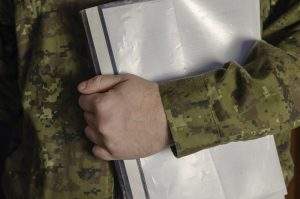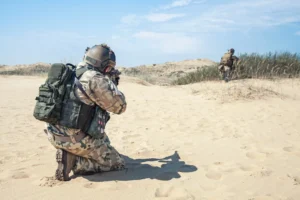Despite promises by the Department of Veterans Affairs, critics of the agency say they don’t trust it to help Marine Corps family members exposed to contaminated water at Camp Lejeune because the VA is still fumbling the cases of sickened veterans two years after Congress ordered they be treated for free or at low cost.
The VA announced last week that it’s ready to begin compensating family members for the out-of-pocket costs they have incurred since March 2013 for 15 medical conditions associated with exposure to chemicals that entered the drinking water at the Eastern North Carolina military base. The Marine Corps has said the water was contaminated with more than a dozen chemicals, including known carcinogens, between 1957 and 1987.
The military has said that between 750,000 and 1 million people – veterans, family members and civilian workers – may have been exposed to contaminated water before the tainted sources were shut down. Diseases or conditions they may have developed that are named in the law are: bladder cancer; miscarriage; breast cancer; multiple myeloma; esophageal cancer; myelodysplastic syndromes; female infertility; neurobehavioral effects; hepatic steatosis; non-Hodgkin’s lymphoma; kidney cancer; renal toxicity; leukemia; scleroderma; and lung cancer.
In 2012, after years of pressure, Congress ordered the VA to take care of veterans and their families who had suffered ill effects from the exposures. The law took effect when President Barack Obama signed it in August of that year.
Jerry Ensminger, a retired Marine who helped lead the fight since 1997 to get care for those sickened by the water at Camp Lejeune, said he is skeptical of the VA because of the time it took for the agency to put in place procedures for compensation. p>
Right away, veterans who had lived on the post while on active-duty for at least 30 days anytime during those three decades and were suffering from any of the 15 ailments were guaranteed no-cost treatment through the VA. Under the law, they do not have to meet income eligibility requirements or receive a VA disability rating first.
Veterans who had lived on post for 30 days during the period when the water was tainted and had not been diagnosed with one of the 15 ailments but have other health issues also are to receive treatment at the VA if they request it, though they have to make co-payments.
“The day the law was signed we started providing care to veterans,” said Dr. Terry J. Walters, deputy chief consultant for the VA’s Public Health, Post-Deployment Health group. So far, Walters said, more than 16,000 veterans have applied for care under the law. Of those, she said, 11,000 to 12,000 have received treatment for at least one of the 15 conditions listed.
Waits for funds and rules
It took until March 2013 for Congress to appropriate money for the VA to help family members affected by the poisons and another 19 months for the agency to develop rules and procedures for providing the aid. In the meantime, Walters said, VA social workers were instructed to help family members who needed it to find treatment options.
Though the VA is the nation’s largest integrated health care system, with more than 1,700 clinics and hospitals across the country, it is set up to treat the millions of veterans who qualify for its services, not their dependents. To meet the requirements of the law, Walters said, the VA chose to let family members get treatment elsewhere, and to reimburse them for the costs their insurance companies do not cover.
So far, Walters said, about 2,500 Marine Corps family members have asked the VA for information about the reimbursement program, and they will receive a letter soon to tell them that payouts can begin. Walters said it’s not known yet how many people will qualify for payments.
She did not immediately know the amount of money Congress has appropriated for the payments, but said, “It was adequate.”
‘Inexcusable’ delay
Ensminger, who was stationed at Camp Lejeune and whose daughter, Janey, died of leukemia in 1985 at age 9, said the more than two years it took after the law was passed for the VA to begin helping families was inexcusable.
Ensminger asked if VA Secretary Robert A. McDonald, who took over the agency in September with a mission to rebuild trust in its troubled health care delivery system, would have allowed such a lag in his former job as CEO of Procter & Gamble.“The answer to that is no,” Ensminger said. “So why would he find it acceptable here?”
Ensminger, who helps run a website that provides information on the Lejeune water contamination, said he has little faith in the VA’s assurances that it will take care of family members. As it does with veterans who say they have medical conditions related to their military service, the VA will have clinicians review family members’ claims that their problems were caused by exposure to the water at Lejeune.
A training slideshow Walters prepared for clinicians who will look at the cases cites a 2009 National Research Council report that says, “The available scientific information does not provide a sufficient basis for determining whether the population of Camp Lejeune has, in fact, suffered adverse health effects as a result of exposure to contaminants in the water supply.”
Cancer rates studied
Mortality studies conducted by the federal Agency for Toxic Substances & Disease Registry found higher rates of cancer among Marine and Navy service members at Camp Lejeune and among civilian workers there compared to those at Camp Pendleton, Calif. But limitations of the studies made it impossible to say definitively the cancers were caused by chemical exposures at Lejeune.
Walters says it is always extremely difficult to say a specific cancer was caused by a particular environmental exposure.
“That’s the VA looking for another reason to deny them benefits,” Ensminger said. “They’re telling screeners, if you can find another reason they might have gotten the cancer, then deny them.”
Lee Ann Andersen of Kyle, Texas, has been fighting scleroderma – an autoimmune disease that causes a hardening of the skin – for more than 19 years, and in 2008 was diagnosed with breast cancer that required a mastectomy. She now believes both are connected to her three years in the Marine Corps from 1976 to 1979, four months of which she spent living in the women’s barracks at Camp Lejeune.
Earlier this year, after hearing about the 2012 law and seeing that she was eligible, Andersen went to the VA for treatment for the scleroderma and follow-up treatment for the breast cancer. She says no one there knew anything about the Camp Lejeune water issue.
Billed for treatments
Eventually, she says, she got enrolled and has been getting good care.
But the VA has billed her insurance for more than $34,000 so far and has billed her for co-payments. She has spent countless hours on the phone, she says, and it is still not straightened out.
Under the law, the VA should cover all the costs.
“Some days, I just get so frustrated, I tell my husband I wish I had never started this,” Andersen said. “Then I get rested up and feel better and say, ‘I’m going to fight this.’
“I feel so let down,” she said. “I mean, I didn’t go off and fight a war or do anything heroic. But I did what I was paid to do, and I get stabbed in the back.”
Congress has not made any provision for providing care or compensation for civilians who worked – some of them for decades – on post during the years the water was contaminated, nor has it addressed service members who were never based at Lejeune but spent more than 30 days at a time there for training.
Ensiminger said he’s glad for the 2012 law but says it should be seen as a start.





